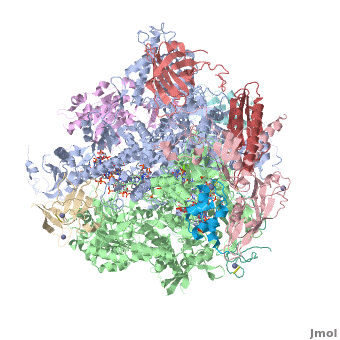Function
RNA polymerase (RNAP, DNA primase, dnaG) catalyzes the addition of nucleotides to RNA during transcription.
DNA-dependent RNA polymerase catalyzes the transcription of RNA from a DNA template. The DNA-dependent eukaryote RNAP[1] are divided to
RNAP I (or Pol I) which transcribes ribosomal RNA[2];
RNAP II (or Pol II) transcribes DNA and most snRNA and microRNA[3]; See RNA Polymerase II.
RNAP III (or Pol III) transcribes tRNA and 5S ribosomal RNA[4].
DNA primase (DNAP) is RNAP which catalyzes the synthesis of the RNA primer which complements an ssDNA template and initiates DNA synthesis[5]. The large subunit of promase is called p58C.
dnaG is a bacterial DNA primase[6].
For DNA-dependent RNA polymerase see
RNA-dependent RNA polymerase or cap-snatching endonuclease or replicase catalyzes the replication of RNA from a RNA template[7]. An example is the Influenza virus RNA polymerase which is composed of 3 subunits. Subunit PA is involved in cap-snatching. Subunit PB1 is involved in RNA synthesis. Subunit PB2 is involved in RNA replication and transcription. It is implicated in endonuclease cleavage of RNA primers. (1qln; blue: nontemplate strand; cyan: template strand; red:RNA).
See also RNA-directed RNA polymerase.
For RNA-dependent RNA polymerase from Hepatitis C virus - NS5B - see
For RNA-dependent RNA polymerase from murine norovirus see
Poly(A) RNA polymerase catalyzes the addition of long poly(A) tails to mRNA without a template[8].
3D Structures of RNA polymerase
RNA polymerase 3D structures

